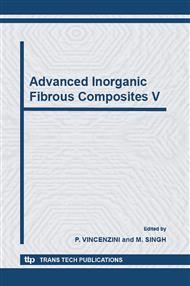[1]
E. Fitzer, A. Burger, in International Conference on Carbon Fibres, their Composites and Applications, London, GB (1971), paper no. 36.
Google Scholar
[2]
C. R. Thomas,.E. J. Walker in Proceedings 5th London International Carbon and Graphite Conference, vol. 1 (1978), p.520 ff.
Google Scholar
[3]
G. Savage: Carbon/Carbon Composites,. Chapman & Hall, (1993).
Google Scholar
[4]
R. Weiss, Carbon Fiber Reinforced CMCs: Manufacture, Properties, Oxidation Protection in High Temperature Ceramic Matrix Composites, Eds. W. Krenkel, R. Naslain, H. Schneider (2001), pp.440-456.
DOI: 10.1002/3527605622.ch69
Google Scholar
[5]
R. Weiss, CFC-Hochtemperaturleichtbauanwendungen, Dresdner Leichtbausymposium (2000).
Google Scholar
[6]
Y. Greenie, in: Looking Ahead for Materials and Processes, Eds. J. de Bossu, G. Briens, P. Lissac, Elsevier, Amsterdam (1987), p.377.
Google Scholar
[7]
W. E. C. Pritzkow, Keramikblech" Properties and Applications, in: , High Temperature Ceramic Matrix Composites, Eds. W. Krenkel, R. Naslain, H. Schneider (2001), pp.681-685.
DOI: 10.1002/3527605622.ch104
Google Scholar
[8]
R. A. Simon, P. Supancic, Thermal Shock Resistance of Nextel 610 and 720 Continuous Fiber-Reinforced Mullite Matrix Composites at 28 th International Conference & Exposition on Advanced Ceramics & Composites, January 25-30, 2004, Cocoa Beach, Florida.
DOI: 10.1002/9780470291191.ch17
Google Scholar
[9]
B. J. Kanka, M. J. A. Schmuecker, Tailored Properties of wound all-oxide CMC´s, at 30 th International Conference & Exposition on Advanced Ceramics & Composites, January 23- 27, 2006, Cocoa Beach, Florida.
Google Scholar
[10]
R. J. Diefendorf, Y. Sohda, in: Extended Abstracts Program 17th Biennial Conference on Carbon, 17 (1983), p.31.
Google Scholar
[11]
A. Becker, K. H. Huettinger, Chemistry and Kinetics of CVD of pyrocarbon, Carbon 36 (1996), pp.225-232.
Google Scholar
[12]
J. Antes, Z. Hu, W. Zhang, K. J. Huettinger in: Carbon, Vol. 37, Issue 12 (1999), p.2031- (2039).
Google Scholar
[13]
R. Naslain, R. Tailler, X. Bourrat, A. Guette, F. Rebillat, J. Lamon, Fiber-Matrix Bonding Control in SiC/SiC Composites via the Use of Enigneered Interphases: an Overview, 13th ICCM Beijing (2001), p.65.
Google Scholar
[14]
W. V. Kotlensky, Chem. Phys. Carbon, 9 (1973), p.173 ff.
Google Scholar
[15]
A. J. Caputo, W. J. Lackey in: Ceram. Eng. Sci. Proc. 5 (1984), p.654 ff.
Google Scholar
[16]
BMBF - Forschungsvorhaben; Foerderkennzeichen: 03N8018B, Entwicklung biomorpher Keramiken fuer die Abgasnachbehandlung, Abschlussbericht, (2005).
Google Scholar


